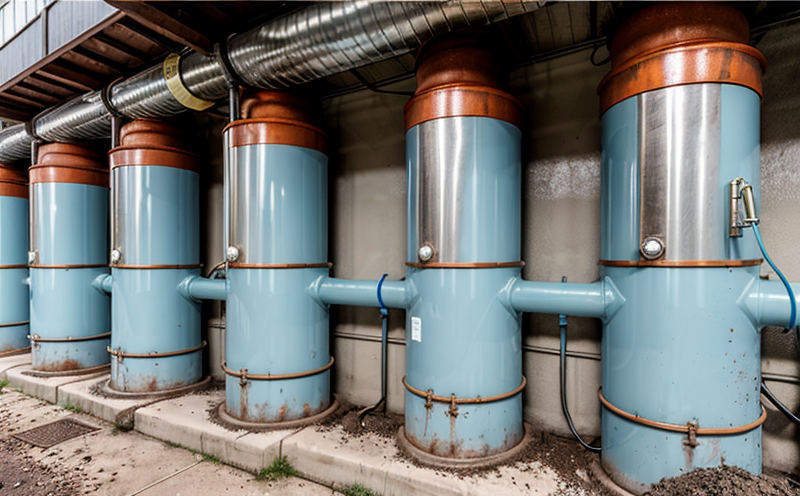ASTM G210 High Temperature Scaling Test in Water Systems
The ASTM G210 high temperature scaling test is a critical method used to assess the potential formation of scale and deposits within water systems. This testing ensures that industrial, commercial, and residential facilities can operate efficiently by minimizing the risk of equipment failure due to clogging or corrosion caused by scale build-up.
Scaling in water systems occurs when dissolved minerals precipitate out of solution as a result of changes in temperature, pressure, or pH levels. These deposits can lead to increased energy consumption, reduced flow rates, and even complete blockages. By identifying the potential for scaling early on, facilities can take proactive measures to mitigate these issues.
The ASTM G210 test method simulates real-world conditions by subjecting a sample of water to elevated temperatures under controlled pressure. This process allows for the accurate prediction of mineral precipitation and subsequent scale formation. The test is particularly useful in identifying the long-term effects that specific water compositions can have on various materials used in water systems.
Proper specimen preparation is crucial for obtaining reliable results from this test. Samples should be prepared according to ASTM G210 guidelines, which include using appropriate containers and ensuring consistent temperature and pressure conditions during the test run. The sample must also represent a typical water composition found within the intended application environment.
Instrumentation plays a key role in accurately measuring both the rate of scaling and the amount of scale formed during the ASTM G210 test. Commonly used equipment includes high-temperature furnaces, pressure vessels, and data logging systems capable of recording temperature and pressure throughout the testing period. These instruments provide precise readings that help determine whether the water composition is likely to cause significant scale formation.
Reporting from the ASTM G210 test typically involves documenting key parameters such as time required for scaling to occur, maximum thickness achieved by any precipitated minerals, and any changes observed in the physical properties of the sample over time. This information can then be used by quality managers and compliance officers to make informed decisions regarding water treatment methods or material selection.
Understanding the significance of this test helps facilities avoid costly disruptions caused by scale build-up. Proper implementation of ASTM G210 standards ensures that potential problems are addressed before they become severe issues, saving both time and money in the long run.
Why It Matters
The importance of understanding how water composition affects scaling cannot be overstated. In many industries, such as power generation, food processing, and pharmaceuticals, maintaining clean and efficient water systems is essential for both operational efficiency and product quality.
- Power Generation: Boiler tubes in steam generators are particularly susceptible to scaling due to their constant exposure to high temperatures and pressures. Accurate prediction of scaling tendencies helps prevent costly downtime associated with tube failures or reduced heat transfer efficiency.
- Food Processing: Cleanliness is paramount in food processing plants, where any trace amounts of scale could contaminate products. ASTM G210 testing ensures that water supplies meet stringent hygiene standards before being used in manufacturing processes.
- Pharmaceuticals: In pharmaceutical applications, purity levels are extremely important. Scale build-up can compromise the integrity of drug formulations and lead to contamination risks. By conducting ASTM G210 tests, manufacturers ensure their water supply meets strict regulatory requirements.
In addition to these specific sectors, there are broader implications for all facilities relying on complex water systems. Properly managed scaling reduces maintenance costs, extends equipment lifespan, improves energy efficiency, and enhances overall system performance.
Applied Standards
The ASTM G210 test is specifically designed to meet the needs of industries dealing with corrosive environments where high temperatures and pressures are common. It aligns closely with other relevant standards such as ISO 9223, which addresses general methods for laboratory determination of corrosion inhibition effectiveness in aqueous systems.
For facilities operating under strict regulatory frameworks, compliance with ASTM G210 is often required to ensure that their water treatment practices meet international standards. This includes organizations governed by EPA regulations or those following EU directives related to industrial emissions and wastewater discharge limits.
International Acceptance and Recognition
- Australia: ASTM G210 is widely accepted in Australia, particularly within the power generation sector. Compliance with this standard ensures that local facilities adhere to best practices recognized globally.
- New Zealand: Similar to its neighbor across the Tasman Sea, New Zealand also recognizes ASTM G210 as a reliable method for evaluating scaling tendencies in water systems.
- Japan: The Japanese Industrial Standards (JIS) incorporate elements of ASTM G210 when specifying requirements for industrial water quality. This integration demonstrates the international relevance and acceptance of this testing procedure.
These examples illustrate how ASTM G210 has become a cornerstone in ensuring consistent quality control across multiple nations, facilitating smoother trade between countries that have adopted these common standards.





